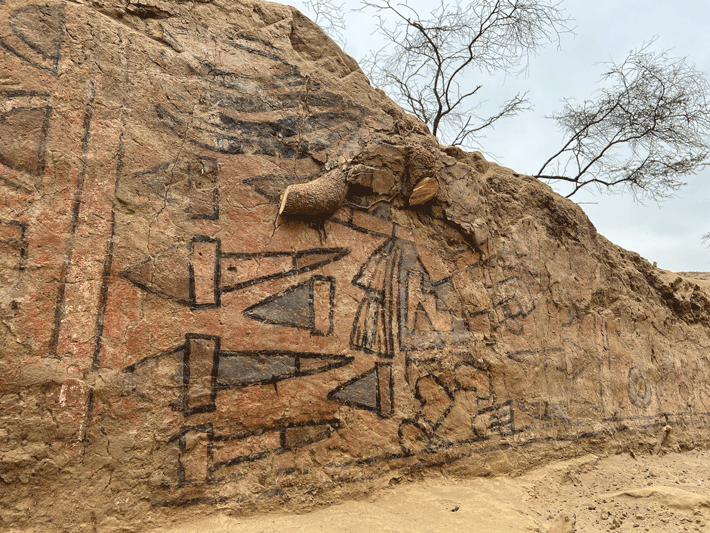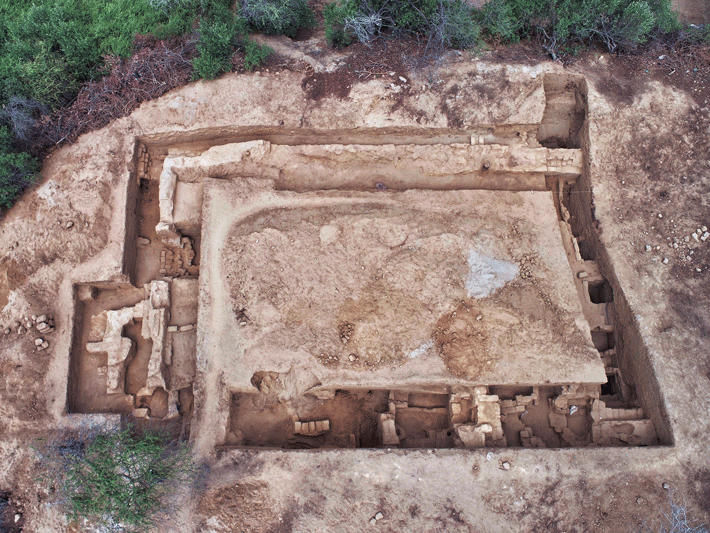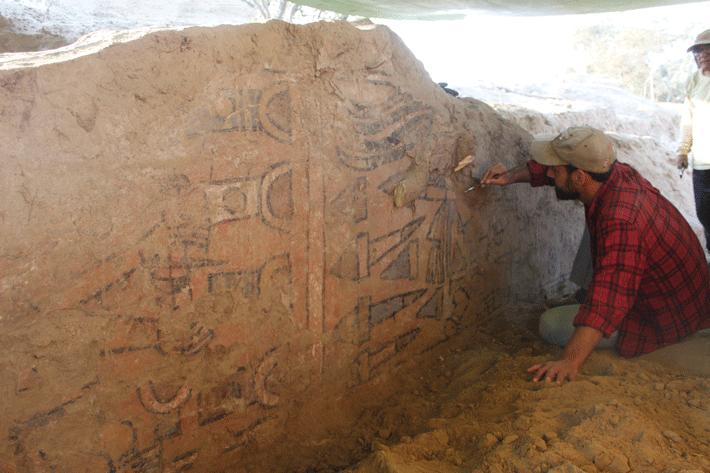Digs & Discoveries
Peru’s Lost Temple
By JARRETT A. LOBELL
Friday, February 10, 2023
 While working toward a degree in Andean studies at the Pontifical Catholic University of Peru, archaeologist Sâm Ghavami took a bus every day from the city of Lambayeque to the town of Pacora along a stretch of the twisty Pan-American Highway. During each trip, in the tiny hamlet of Illimo, the bus passed a blue sign next to the road indicating a historical or archaeological site that read Huaca Pintada, or Painted Temple. When Ghavami finally had a chance to get off the bus and visit the site, he didn’t see much resembling an ancient temple, but instead came upon an abandoned mound covered by trees, weeds, and garbage. “It was in really bad shape,” he says. “If I hadn’t known it was a huaca, it would have been difficult to tell that it was an archaeological site.”
While working toward a degree in Andean studies at the Pontifical Catholic University of Peru, archaeologist Sâm Ghavami took a bus every day from the city of Lambayeque to the town of Pacora along a stretch of the twisty Pan-American Highway. During each trip, in the tiny hamlet of Illimo, the bus passed a blue sign next to the road indicating a historical or archaeological site that read Huaca Pintada, or Painted Temple. When Ghavami finally had a chance to get off the bus and visit the site, he didn’t see much resembling an ancient temple, but instead came upon an abandoned mound covered by trees, weeds, and garbage. “It was in really bad shape,” he says. “If I hadn’t known it was a huaca, it would have been difficult to tell that it was an archaeological site.”
Yet Ghavami did know about the Huaca Pintada and had been intrigued by the very few published articles to mention the temple, which was built by members of the Moche culture that thrived in this part of Peru from the first to ninth century A.D. One of these sources was a 1917 paper in which the German ethnologist Hans Heinrich Brüning wrote a single paragraph about the site. The other was a 1978 article by University of Texas at Austin anthropologist Richard Schaedel in ARCHAEOLOGY magazine that featured photographs Brüning had taken before looters ransacked the site, which had not been previously published. By 2018, when Ghavami decided that he wanted to excavate Huaca Pintada, Brüning’s original photos had been lost, nothing had been written about the site in 40 years, and the murals were believed to have been completely destroyed. Over the last four years, Ghavami, now at the University of Fribourg, and his codirector, archaeologist Christian Cancho Ruiz of the University of Virginia, have found this belief to be mistaken. They have discovered that beneath the overgrown vegetation and abandoned objects are sections of the mural that even Brüning had not seen and that will add to archaeologists’ understanding of the complexity of the culture that created the vibrant paintings more than 1,000 years ago.
Like the highway itself, Ghavami’s path to discovery was far from straight. “The huaca is on private land which has been in the Granados family for at least 150 years, and I had a hard time convincing the current owner, Don Augusto Granados, to let us excavate the site,” Ghavami says. “Although he had turned others down before, he agreed at first, but changed his mind, so we excavated a part of the site owned by other families. We didn’t really find much that could have related to the paintings, so I went looking for help.” It came in the form of a local shaman who University at Buffalo anthropologist Ana Mariella Bacigalupo had worked with during her research in the region. The shaman led an eight-hour ritual in his own home to communicate with the huaca and encourage it to accept Ghavami so the Granados family would accept him as well. “He was kind of a diplomat,” Ghavami says. “In the following days, he went to see Don Augusto several times and talked about me to make sure his ritual would work.”
Ghavami and his team returned to Illimo in 2021 only for Granados to turn him down again. “We couldn’t excavate the huaca,” Ghavami recalls, “so we dug a bit in the Picantería la Huaca restaurant just a few feet away, but there wasn’t much there either.” Ghavami got to know one of the Granados sons, who was supportive of the project, and they worked together to ensure that the excavation would benefit the family and the village. Ghavami also spoke often with local residents, many of whom shared traditional stories about the painted temple that had been passed down for centuries.

After a month, Granados finally allowed the team to begin excavating the huaca. During three weeks of digging, Ghavami’s team unearthed a few fragments of painted wall plaster. “We were so close, but so far because it seemed that the fragments belonged to a painted wall from another period,” he says. “And I didn’t know if we would be allowed to come back.”
In the fall of 2022, Granados finally gave the project the full go-ahead, and little by little, the team started to find more traces of the mural. Brüning’s photos show six helmeted warriors in profile carrying weapons on the left side and five additional warriors, many wearing highly decorative headdresses with trailing black feathers, on the right. Each of the 11 warriors is surrounded by dozens of geometric shapes. The warriors all walk toward a large central deity who stands on a platform, has sharp-clawed feet, and wears an elaborately patterned garment. All the warriors documented by Brüning, along with most of the central figure, were subsequently lost. However, Ghavami discovered depictions of an additional four warriors on the left and five on the right, all of which are well preserved.
Using Brüning’s photos, Schaedel had calculated that the entire mural measured almost 51 feet long, but Ghavami’s team has revealed that it is actually nearly 100 feet long and once stood about 10 feet high. The mural’s upper panel is now destroyed but is known from Brüning’s photos to have contained images of rivers, fish, birds, and small human figures. “The scene represented on the mural seems to be inspired by a strong idea of sacred hierarchy built around a cult to the ancestors and their intimate relation with the forces of nature,” says Ghavami. “The warriors may represent a special status, like caciques, or chiefs of a sociopolitical group, who all seem to recognize the greater authority of this central deity.”
 The Huaca Pintada mural was created during a period of change, when the people of the Moche culture began to transition into the Lambayeque culture that would dominate the region for nearly the next five centuries. “We want to understand how you get from one culture to a new one, how collective identity is created,” Ghavami says. The mural is a powerful new piece of evidence because it combines elements of Moche iconography and style with later Lambayeque motifs. “One example,” says Ghavami, “is that there is only a single main deity represented facing forward, which is very unusual for Moche art, but quite common for the Lambayeque.”
The Huaca Pintada mural was created during a period of change, when the people of the Moche culture began to transition into the Lambayeque culture that would dominate the region for nearly the next five centuries. “We want to understand how you get from one culture to a new one, how collective identity is created,” Ghavami says. The mural is a powerful new piece of evidence because it combines elements of Moche iconography and style with later Lambayeque motifs. “One example,” says Ghavami, “is that there is only a single main deity represented facing forward, which is very unusual for Moche art, but quite common for the Lambayeque.”
For now, Ghavami’s explorations of the Huaca Pintada are complete and the mural has been covered while he investigates the best way to conserve it and restore the damaged sections. “In Peru before we excavate a site,” he says, “we conduct a ceremony called the ‘pago a tierra’ to give offerings of chicha, corn, or candy—or in my case chocolate because I’m Swiss—to the earth or the huaca in hopes that the huaca will receive us and to ensure a good field season. I think the huaca knows me now and I feel more welcomed every time I go there.”
Advertisement
Advertisement
IN THIS ISSUE
Digs & Discoveries
Peru’s Lost Temple
Bird Brains
Standing Swords
Earliest Ayahuasca Trip
Early Medieval Elegance
L is for Lice
Weapons of Choice
Winter Light
Closely Knit
Mounds in the Family
Off the Grid
Around the World
Snacking in the Colosseum, Japanese tomb statue, Attila the Hun’s motives, 300,000-year-old fur coats, and Egyptian crocodiles in the afterlife
Artifact
Tunes for all time
Advertisement

Recent Issues
-
 May/June 2024
May/June 2024
-
 March/April 2024
March/April 2024
-
 January/February 2024
January/February 2024
-
 November/December 2023
November/December 2023
-
 September/October 2023
September/October 2023
-
 July/August 2023
July/August 2023
-
 May/June 2023
May/June 2023
-
 March/April 2023
March/April 2023
-
 January/February 2023
January/February 2023
-
 November/December 2022
November/December 2022
-
 September/October 2022
September/October 2022
-
 July/August 2022
July/August 2022
-
 May/June 2022
May/June 2022
-
 March/April 2022
March/April 2022
-
 January/February 2022
January/February 2022
-
 November/December 2021
November/December 2021
-
 September/October 2021
September/October 2021
-
 July/August 2021
July/August 2021
-
 May/June 2021
May/June 2021
-
 March/April 2021
March/April 2021
-
 January/February 2021
January/February 2021
-
 November/December 2020
November/December 2020
-
 September/October 2020
September/October 2020
-
 July/August 2020
July/August 2020
-
 May/June 2020
May/June 2020
-
 March/April 2020
March/April 2020
-
 January/February 2020
January/February 2020
-
 November/December 2019
November/December 2019
-
 September/October 2019
September/October 2019
-
 July/August 2019
July/August 2019
-
 May/June 2019
May/June 2019
-
 March/April 2019
March/April 2019
-
 January/February 2019
January/February 2019
-
 November/December 2018
November/December 2018
-
 September/October 2018
September/October 2018
-
 July/August 2018
July/August 2018
-
 May/June 2018
May/June 2018
-
 March/April 2018
March/April 2018
-
 January/February 2018
January/February 2018
-
 November/December 2017
November/December 2017
-
 September/October 2017
September/October 2017
-
 July/August 2017
July/August 2017
-
 May/June 2017
May/June 2017
-
 March/April 2017
March/April 2017
-
 January/February 2017
January/February 2017
-
 November/December 2016
November/December 2016
-
 September/October 2016
September/October 2016
-
 July/August 2016
July/August 2016
-
 May/June 2016
May/June 2016
-
 March/April 2016
March/April 2016
-
 January/February 2016
January/February 2016
-
 November/December 2015
November/December 2015
-
 September/October 2015
September/October 2015
-
 July/August 2015
July/August 2015
-
 May/June 2015
May/June 2015
-
 March/April 2015
March/April 2015
-
 January/February 2015
January/February 2015
-
 November/December 2014
November/December 2014
-
 September/October 2014
September/October 2014
-
 July/August 2014
July/August 2014
-
 May/June 2014
May/June 2014
-
 March/April 2014
March/April 2014
-
 January/February 2014
January/February 2014
-
 November/December 2013
November/December 2013
-
 September/October 2013
September/October 2013
-
 July/August 2013
July/August 2013
-
 May/June 2013
May/June 2013
-
 March/April 2013
March/April 2013
-
 January/February 2013
January/February 2013
-
 November/December 2012
November/December 2012
-
 September/October 2012
September/October 2012
-
 July/August 2012
July/August 2012
-
 May/June 2012
May/June 2012
-
 March/April 2012
March/April 2012
-
 January/February 2012
January/February 2012
-
 November/December 2011
November/December 2011
-
 September/October 2011
September/October 2011
-
 July/August 2011
July/August 2011
-
 May/June 2011
May/June 2011
-
 March/April 2011
March/April 2011
-
 January/February 2011
January/February 2011
Advertisement






